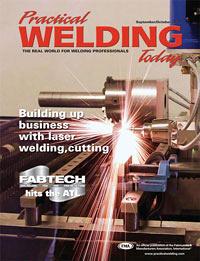President
- FMA
- The Fabricator
- FABTECH
- Canadian Metalworking
Categories
- Additive Manufacturing
- Aluminum Welding
- Arc Welding
- Assembly and Joining
- Automation and Robotics
- Bending and Forming
- Consumables
- Cutting and Weld Prep
- Electric Vehicles
- En Español
- Finishing
- Hydroforming
- Laser Cutting
- Laser Welding
- Machining
- Manufacturing Software
- Materials Handling
- Metals/Materials
- Oxyfuel Cutting
- Plasma Cutting
- Power Tools
- Punching and Other Holemaking
- Roll Forming
- Safety
- Sawing
- Shearing
- Shop Management
- Testing and Measuring
- Tube and Pipe Fabrication
- Tube and Pipe Production
- Waterjet Cutting
Industry Directory
Webcasts
Podcasts
FAB 40
Advertise
Subscribe
Account Login
Search
Aluminum Workshop: Weldability of aluminum mold plate
- By Frank Armao
- November 26, 2014
- Article
- Aluminum Welding
Q: I’m trying to weld some very thick aluminum mold plate. I don’t know what the alloy is. The plate thickness is about 12 in. I’m having lots of cracking problems. Can you tell me what the problem might be?
A: In the way of background, most of the molds used for injection or blow molding parts are made from very thick aluminum alloys. Quite a few aluminum companies supply these alloys under trade names. Very often the chemistry and official alloy designation may not be supplied by the material supplier, who often sells it only by trade name. So how do you know what you have, and how to weld it?
Virtually all of the mold plate alloys, whether cast or wrought, are made from 2XXX or 7XXX alloys, often variations of 2618 or 7075. As I hope at least some of you remember, neither of these alloys is considered to be weldable. Both of them are very prone to develop weld or HAZ cracks. A certain amount of cracking is to be expected when welding these alloys. For this reason, it is never recommended to weld any of the mold plate alloys in structural applications. For example, I would never recommend welding lifting lugs on mold plates. Drill and tap and bolt lifting lugs on instead.
However, there is one application in which it is common and acceptable to weld on aluminum mold plates. Sometimes an area in the mold part cavity is mismachined. Other times the mold wears excessively after a period of use. In both these cases, it’s common that the affected area is preheated to 240 degrees F, built up using GTAW or GMAW, and then remachined. Which filler metal should you use? I can’t give you a definitive answer, because there are so many alloys available. However, I would try 4043 first.
You may still encounter cracking when using 4043, and cast mold plate is prone to containing gas pockets when you weld over them. If these problems occur, grind out the crack or porosity and weld it again. A word of caution: It is not unusual to have to repeat this cycle several times before the crack or porosity is completely removed.
About the Author

Frank Armao
Aluminum Consulting Inc.
440-479-0239
About the Publication
Related Companies
subscribe now

The Welder, formerly known as Practical Welding Today, is a showcase of the real people who make the products we use and work with every day. This magazine has served the welding community in North America well for more than 20 years.
start your free subscription- Stay connected from anywhere

Easily access valuable industry resources now with full access to the digital edition of The Fabricator.

Easily access valuable industry resources now with full access to the digital edition of The Welder.

Easily access valuable industry resources now with full access to the digital edition of The Tube and Pipe Journal.
- Podcasting
- Podcast:
- The Fabricator Podcast
- Published:
- 04/16/2024
- Running Time:
- 63:29
In this episode of The Fabricator Podcast, Caleb Chamberlain, co-founder and CEO of OSH Cut, discusses his company’s...
- Industry Events
16th Annual Safety Conference
- April 30 - May 1, 2024
- Elgin,
Pipe and Tube Conference
- May 21 - 22, 2024
- Omaha, NE
World-Class Roll Forming Workshop
- June 5 - 6, 2024
- Louisville, KY
Advanced Laser Application Workshop
- June 25 - 27, 2024
- Novi, MI
































